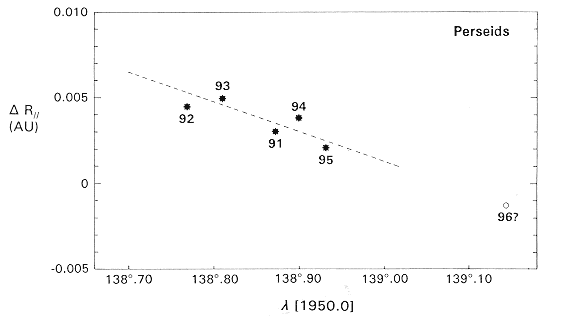Within a few days we will experience a very favourable Perseid meteor maximum: it will be new moon on August 14! Below, some predictions on when a possible 'new' peak will occur, as well as information on the position of the main annual peak and other aspects of this coming return.

Left: Position of the Perseid radiant between the end of July and the end of August. In one month the Perseid radiant moves from the constellation of Andromeda via Perseus to Camelopardalis.
A still very preliminary model on meteor outburst mechanics suggests a time of peak occurence different from an earlier prediction. If the model is correct (which remains to be proved), remnants of the 'new' Perseid peak (the outburst component) might occur near 5h UT (+- 1hr) on August 12 instead of near 0:30 UT as previously predicted.
Not so long ago we issued a prediction on when possible remnants of the 'new' Perseid peak of last years might re-occur. This prediction was based on simple extrapolation of the patterning in peak postion, the decreasing shift in increasing solar longitude over the last years.

Right: Diagram showing the peak position in solar longitude (1950.0) of the Perseid outburst component over the years 1991-1995 as a function of the barycentric displacement of the sun parallel to the earth orbit (D R//). The theoretical position for the 1996 peak is shown by an open circle.
However, things might be different and it might be that the quite neat behaviour of the 'patterning' in the period 1992-1995 was truly coincidental (!). Recently developed idea's, which are, let me stress, however still in a very preliminary state, suggest that for outbursts of streams originating from comets with 'longer' periods and large inclination, the peak occurences are connected to the shift of the solar system barycenter [1]. While the theory has been developed for 'far cometary type' outbursts, the same mechanics could be at work with the Perseid outbursts (which are of 'near comet' type) since the encounter conditions between Earth and cometary orbit are somewhat similar to those of 'far cometary' type outbursts producing long period comets [1].
There seems to be indeed some tentative correlation between the solar reflex motion and the peak solar longitudes of the Perseid outbursts in the period 1991-1995 [2]. If the tentative correlations produced hold (which remains to be seen), this would suggest a possible re-occurence (provided that 'fresh' dust of comet Swift-Tuttle is still present near the cometary node this year) of the outburst peak component around 5h UT (+- ~1h) on August 12.
This is a time considerably deviant from that believed previously. Yet, be very cautious: all this theoretical grappling is still in an experimental state, and their actual validity is yet to be proven! On the other hand, the model has the advantage that all peak positions of the previous years, including those of the preperihelion years, fit in well untill now.
The message is, that a lot is still uncertain about the time at which an outburst component (if any left) might re-occur and that the odds might be at least as good for the USA as for Europe this year. So, the best thing observers all over the world can do is to start observations in early evening twilight and to proceed untill morning dawn. However, don't be disappointed when nothing happens around either 5h UT or 0:30 UT. In that case, you just enjoy a very favourable display of the annual Perseid stream. Good luck to all of you!
- Jenniskens P.: Meteor stream activity IV. Meteor outbursts and the reflex motion of the Sun. Astron. Astroph. (in press).
- Langbroek M.: Perseiden houden de spanning er in. Radiant 18, nr. 4 (1996) pg. 59-62).
Marco Langbroek (Dutch Meteor Society)
Jan Steenlaan 46
NL-2251 JH Voorschoten
The Netherlands